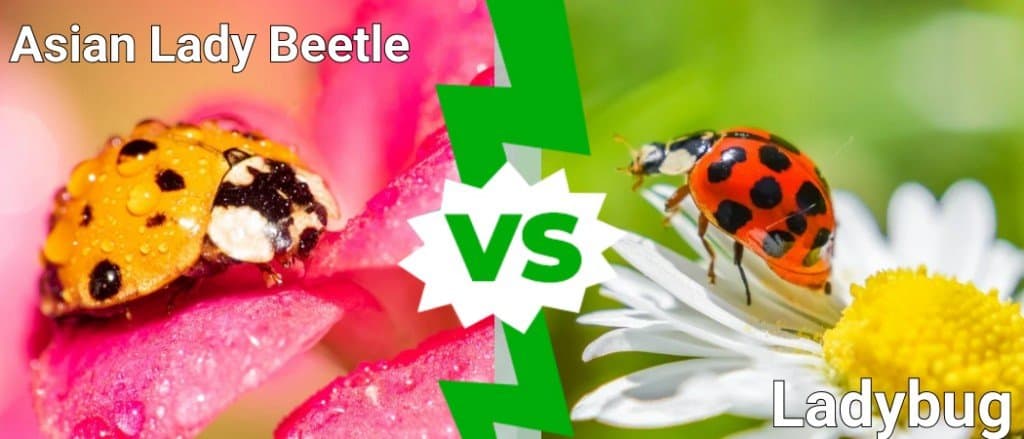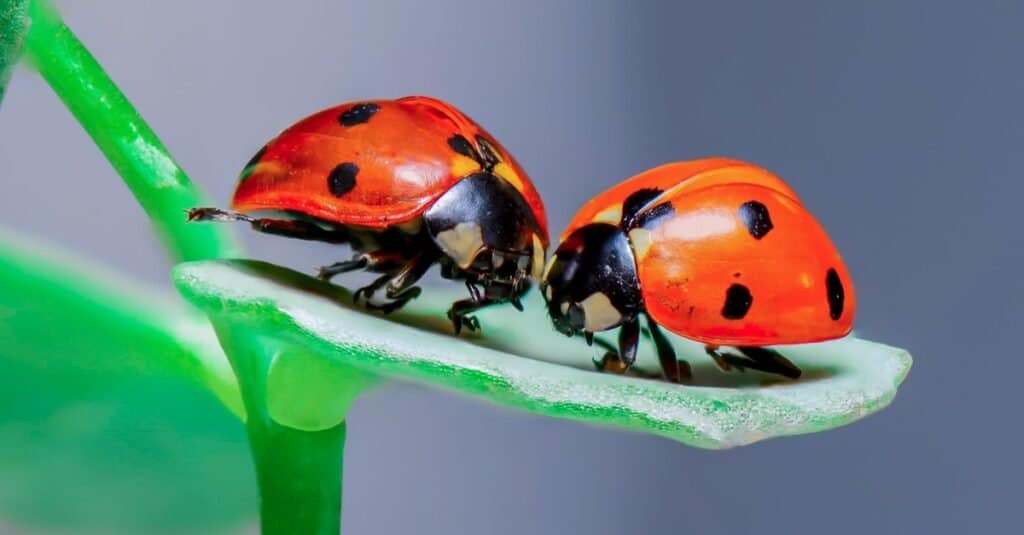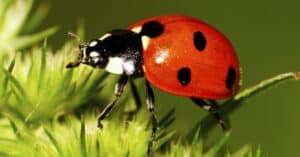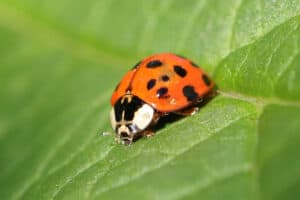Ladybugs vs. Asian beetles are often confused for one another and it’s certainly an easy mistake to make given how similar they are. After all, they’re both small, brightly colored flying insects with similar markings. And just to make things even more confusing, Asian beetles are actually a species of ladybugs. Both insects are often found in the same habitat and they eat much of the same things. So, considering how alike they are, is it actually possible to tell them apart? The answer is yes and there are actually quite a few key differences between them.
Comparing Asian Beetle vs. Ladybug

Although there are some variations between species of ladybugs, we’ll concentrate on the differences between Asian beetles and the more common (and harmless) ladybugs.
Check out the chart below to learn a few of the main differences.
| Asian Beetle | Ladybug | |
| Location | Native to Asia, introduced to North America and Europe, also now established in Africa and South America | Almost worldwide |
| Size | 0.22 to 0.33 inches | Up to 0.31 inches |
| Color | Varies from red to orange | Bright red with black spots |
| Shape | Oval with pointed head and snout | Rounded or slightly oval |
| Head | Small M or W shape on white area behind head | Black head with small white markings on sides of head |
| Behavior | Enters homes and buildings during winter and spring | Spends winter in sheltered locations outdoors |
| Sticky Liquid | Yes | No |
| Bite | Yes | No |
| Diet | Aphids, small insects, fruit | Aphids and other small insects |
| Predators | Birds, spined soldier bugs, red fire ants | Birds, frogs, wasps, spiders, dragonflies |
The Main Differences Between Ladybugs and Asian Beetles
Both Asian Beetles and Ladybugs have differences in their size, shape, and facial markings. Lady buys have a bright red appearance with black spots while Asian beetles mostly vary from red to orange. Moreover, Asian beetles are slightly longer than ladybugs.
But that’s not all, so join us as we discover exactly how to spot the differences between ladybugs and Asian beetles.
Ladybug vs. Asian Beetle: Color

Asian beetle vary from orange to red color while ladybugs are bright red.
©Milton Buzon/Shutterstock.com
One of the easiest ways to tell ladybugs and Asian beetles apart is their color. Ladybugs are always bright red with black spots. The number of spots varies depending on the species, but one of the most common is the seven-spot variety. On the other hand, Asian beetles vary in color from red to orange. Additionally, Asian beetles have many spot patterns, but even sometimes do not have any spots on their wing covers.
Ladybug vs. Asian Beetle: Shape
Another difference between ladybugs and Asian beetles is their shape. Ladybugs typically have a rounded or oval appearance, which is apparent even across the shape of their head. However, while Asian beetles also have an oval appearance, they are slightly longer and have a pointed head and snout.
Ladybug vs. Asian Beetle: Head
One of the most distinctive differences between ladybugs and Asian beetles is the markings on their heads. Ladybugs have black heads with small white markings on the side of their head. These small markings often give the appearance of cheeks.
Along with their more pointed head, Asian beetles have noticeable markings. All Asian beetles have a dark marking on the white area behind their head which can be in the shape of an “M” or a “W”. Sometimes this marking can be large and other times it can be tiny but it is always there on every Asian beetle.
Ladybug vs. Asian Beetle: Behavior
The behavior of Asian beetles and ladybugs differs vastly and is actually one of the easy ways to tell the two apart. Quite simply, ladybugs don’t seek warm shelter indoors during the winter but Asian beetles do.
Asian beetles regularly enter homes and buildings during the winter and early spring to seek shelter. They can often be seen congregating in large groups around window frames and doors, or in any area where they are unlikely to be disturbed. Not only that, but Asian beetles bite by scraping the skin when they land on it. They also excrete a foul-smelling yellow liquid from their leg joints when they are disturbed. This is known as “reflex bleeding” and comes out when they are crushed too. Although this secretion isn’t dangerous it does have a strong odor and it can stain walls, ceilings, fabrics, and other surfaces. It can also cause minor allergic reactions.
Ladybug vs. Asian Beetle: Diet

Ladybugs are considered to be extremely beneficial as they eat aphids which damage crops
©Pixabay / CC0, Pexels – License
Ladybugs are harmless insects that are extremely beneficial to crops and gardens because they eat pest insects. They eat aphids which are small sap-sucking insects – such as the greenfly and the blackfly – which feed on plants and crops, often damaging them.
Although Asian beetles also eat pesky aphids, the benefits that they provide are generally outweighed by their bad points. This is because they also infest and eat fruit such as apples, grapes, and raspberries. Although it can be argued that they only invade fruit that has already been breached by worms or birds, it is generally agreed that they do spoil quite a lot of fruit.
FAQ’s (Frequently Asked Questions)
Are Asian beetles and ladybugs from the same family group?
Yes, Asian beetles and ladybugs are from the same family group because Asian beetles are actually a species of ladybug. There are around 5,000 different species of small beetles that make up the family group Coccinellidae and are commonly known as ladybugs. Asian beetles (Harmonia axyridis) belong to the Coccinellinae subfamily and genus Harmonia.
Why are Asian beetles sometimes called “the many-named ladybird”?
Asian beetles are sometimes called the many named ladybirds because they are known by so many other names. Their other names include harlequin, multicolored Asian beetle, Asian lady beetle, Halloween beetle, and the pumpkin ladybird.
Are Asian beetles pests?
Yes, Asian beetles are commonly classed as a pest because of their behavior which we’ve described. Compared to ladybugs, they generally don’t behave in a good way – they eat and spoil fruit, invade homes, bite, and excrete a smelly liquid.
What is the Difference Between the Larvae of the Ladybug and the Asian Beetle?

The Asian beetle has a longer spine than the ladybug and its orange spots are located in the middle as well as on both sides.
©Marcel Zurreck / CC BY-SA 3.0, , via Wikimedia Commons – License
The larvae between these two insects can be identified by their colors. The larvae of a native ladybug has a large smooth grey body with a small spine and red/orange spots. Their larvae can grow between 1/25 of an inch and 3/8 of an inch in length. They last in their larval stage for around one month, which is when they are ready to pupate and attach themselves to the undersides of leaves.
The larvae of an Asian beetle has a dark grey to black body, with a long spine and orange spots that are located on both sides and in the middle. Asian beetle larvae can grow up to 1/3 of an inch in length and last in this stage for about 15 to 25 days. Like the ladybug, during this stage, they will molt four times before entering the pupa stage.
The photo featured at the top of this post is © iStock.com/Henrik_L
Thank you for reading! Have some feedback for us? Contact the AZ Animals editorial team.






